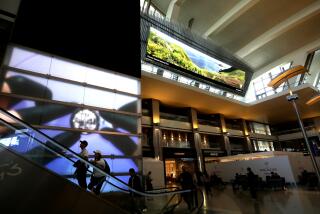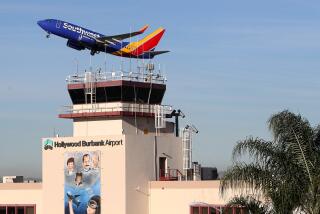Airport Ideas Take Off After O’Hare Delays
CHICAGO — The decades-old debate over whether to build a third airport here has regained urgency after delays at O’Hare International Airport reached all-time highs this year and federal officials pushed for a change.
The problem, regulators say, is that O’Hare and Midway International, the region’s other airport, cannot accommodate all the flights passing through, causing delays that affect airports across the country.
After prodding from federal regulators, airlines agreed to trim their schedules from as many as 110 arrivals to 88 inbound flights an hour during peak times. The cuts, scheduled to begin Nov. 1, will last for six months.
“But that is a short-term solution to a very long-term problem,” said Jay R. Franke, assistant director of the Transportation Center at Northwestern University and a former Chicago commissioner of aviation. “Something else needs to be done.”
City officials say the solution rests on a $15-billion master plan to expand and update O’Hare.
Critics say the expansion won’t deal with the problem of limited airspace. Instead, they say, it’s time to build a third airport.
“Whatever happens, the capacity needs to be expanded, and it needs to be done as quickly as possible,” said Joe Del Balzo, aviation consultant and former acting head of the Federal Aviation Administration.
Suggestions on how -- and whether -- to build a third airport in the Chicago area have been considered and rejected many times in the last 20 years.
Proposals included one to build outside Peotone, a farming community about 40 miles south of downtown Chicago. In 1992, the plan was for two runways and 50 gates spread across 15,000 acres. Over time, the project grew bigger.
The plan was put on hold when government financing fell through and none of the major airlines would invest in the airport.
In 1995, Rep. Jesse L. Jackson Jr. (D-Ill.) addressed the aviation capacity crisis by reviving the Peotone idea and proposing to pay for a scaled-down airport through private investment. His vision is to build a five-gate terminal and a single runway. State officials say it would cost $500 million to buy the land, build the airport and put in new roads.
Will County, where Peotone is located, is putting together a competing plan for an airport at the same location that relies heavily on federal and local funding.
“Our plan is further along and is ready to go,” Jackson said. His proposal, which was submitted to state transportation officials this month, calls for the airport to be completed by 2009.
The state is expected to select one of the two Peotone plans by year’s end; federal officials will then study it, a process that could take another year.
Jackson has lined up an estimated $200 million from private investors, which would cover the cost of the terminal, runway and a parking lot. LCOR, a Pennsylvania real estate developer, and SNC-Lavalin, a Montreal infrastructure company, have signed up for the first round of financing.
The incentive, the companies say, is profiting from a growing, long-term venture. They would receive revenues from the terminal and from the landing fees that airlines pay, as well as customer services such as parking, car rentals and concessions.
The state has bought about half of the 4,400 acres needed for the initial construction, Jackson said. The plan calls for the airport to expand over time to four runways.
“A third airport can be built quicker, safer and cleaner than any plan to expand O’Hare,” Jackson said.
Many airlines have shied away from Jackson’s private enterprise, with some saying they don’t want to shift any flights to a new airport and risk losing customers.
“You can pour concrete in a cornfield. But if no planes come, it’s just concrete in a cornfield,” said Franke, the Northwestern transportation official.
One of critics’ key concerns is how long it would take to build a third airport. They acknowledge there’s no quick answer, because expanding O’Hare could drag out for more than a decade and severely affect surrounding towns.
The $15-billion O’Hare master plan includes $6.6 billion for expansion. Among other things, the money would overhaul runways to make them more efficient. A terminal would also be added to the airport’s western side. The work is to begin next year and be completed by 2013.
City officials are strongly supporting the expansion project to keep millions of dollars in tax and business revenues inside Chicago city limits.
Opponents have filed papers with the FAA, asking the agency to reject the expansion and deny federal funding because the plan did not pass legal or regulatory requirements. They are trying to block it, in part, to protect two communities and two cemeteries that sit in the path of the expansion.
“The bulldozers cannot destroy our communities until the FAA says so,” said Joseph Karaganis, a lawyer who represents the villages of Bensenville and Elk Grove, which would lose homes and businesses in the expansion.
Critics also say there is only so much the crowded airspace above O’Hare can handle. The number of Americans flying and the amount of flights scheduled are reaching pre-Sept. 11 levels.
“After 9/11, the airlines had a couple years of breathing room,” Franke said. “Now, the number of operations is up and only going up.”
One thing everyone can agree on is that delays and other travel problems at O’Hare have become unbearable.
Tara Tillson walked through the security line at O’Hare and found a coffee shop to grab a latte. The 43-year-old investment banker from Los Angeles waited in line, not worried whether she would miss her connecting flight.
“My flight landed an hour late. My connection is leaving an hour late,” Tillson said. “This is why I hate flying through O’Hare. Same thing happens at Midway. I wish there was another option.”
On a perfect day, the FAA says, when the skies are clear and there is no wind, the airport can safely handle 200 planes arriving and departing on its seven runways in the span of an hour. But in the past, during peak hours, the airport has had as many as 220 arrivals and departures an hour.
Since January, more than 58,600 flights at O’Hare have been delayed, a figure that tops the annual totals from 2000, 2001 and 2002.
Airline officials agreed to reduce the number of flights out of O’Hare after Transportation Secretary Norman Y. Mineta called them to a meeting in Washington. Mineta said he told airline officials that they could willingly agree to the flight caps, or federal regulators would force the reductions.
FAA Administrator Marion C. Blakey told airline officials: “We cannot let schedules at O’Hare hold the whole system hostage.”
More to Read
Sign up for Essential California
The most important California stories and recommendations in your inbox every morning.
You may occasionally receive promotional content from the Los Angeles Times.










